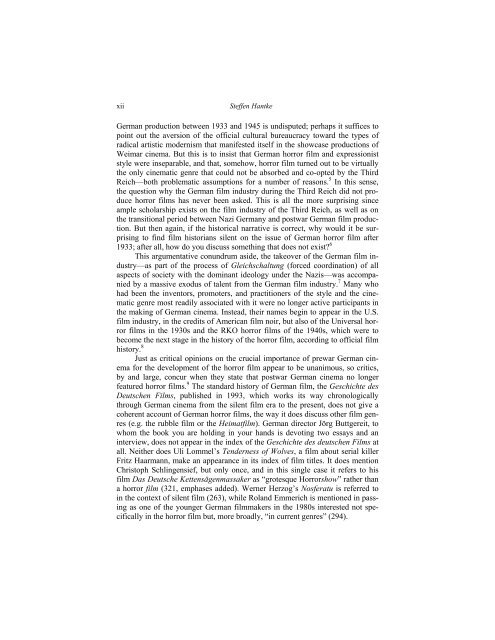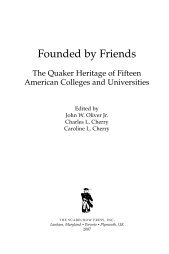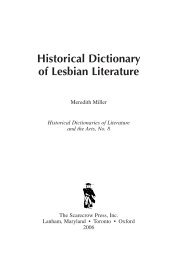Postwar German Cinema and the Horror Film - Scarecrow Press
Postwar German Cinema and the Horror Film - Scarecrow Press
Postwar German Cinema and the Horror Film - Scarecrow Press
You also want an ePaper? Increase the reach of your titles
YUMPU automatically turns print PDFs into web optimized ePapers that Google loves.
xii Steffen Hantke<br />
<strong>German</strong> production between 1933 <strong>and</strong> 1945 is undisputed; perhaps it suffices to<br />
point out <strong>the</strong> aversion of <strong>the</strong> official cultural bureaucracy toward <strong>the</strong> types of<br />
radical artistic modernism that manifested itself in <strong>the</strong> showcase productions of<br />
Weimar cinema. But this is to insist that <strong>German</strong> horror film <strong>and</strong> expressionist<br />
style were inseparable, <strong>and</strong> that, somehow, horror film turned out to be virtually<br />
<strong>the</strong> only cinematic genre that could not be absorbed <strong>and</strong> co-opted by <strong>the</strong> Third<br />
Reich—both problematic assumptions for a number of reasons. 5 In this sense,<br />
<strong>the</strong> question why <strong>the</strong> <strong>German</strong> film industry during <strong>the</strong> Third Reich did not produce<br />
horror films has never been asked. This is all <strong>the</strong> more surprising since<br />
ample scholarship exists on <strong>the</strong> film industry of <strong>the</strong> Third Reich, as well as on<br />
<strong>the</strong> transitional period between Nazi <strong>German</strong>y <strong>and</strong> postwar <strong>German</strong> film production.<br />
But <strong>the</strong>n again, if <strong>the</strong> historical narrative is correct, why would it be surprising<br />
to find film historians silent on <strong>the</strong> issue of <strong>German</strong> horror film after<br />
1933; after all, how do you discuss something that does not exist? 6<br />
This argumentative conundrum aside, <strong>the</strong> takeover of <strong>the</strong> <strong>German</strong> film industry—as<br />
part of <strong>the</strong> process of Gleichschaltung (forced coordination) of all<br />
aspects of society with <strong>the</strong> dominant ideology under <strong>the</strong> Nazis—was accompanied<br />
by a massive exodus of talent from <strong>the</strong> <strong>German</strong> film industry. 7 Many who<br />
had been <strong>the</strong> inventors, promoters, <strong>and</strong> practitioners of <strong>the</strong> style <strong>and</strong> <strong>the</strong> cinematic<br />
genre most readily associated with it were no longer active participants in<br />
<strong>the</strong> making of <strong>German</strong> cinema. Instead, <strong>the</strong>ir names begin to appear in <strong>the</strong> U.S.<br />
film industry, in <strong>the</strong> credits of American film noir, but also of <strong>the</strong> Universal horror<br />
films in <strong>the</strong> 1930s <strong>and</strong> <strong>the</strong> RKO horror films of <strong>the</strong> 1940s, which were to<br />
become <strong>the</strong> next stage in <strong>the</strong> history of <strong>the</strong> horror film, according to official film<br />
history. 8<br />
Just as critical opinions on <strong>the</strong> crucial importance of prewar <strong>German</strong> cinema<br />
for <strong>the</strong> development of <strong>the</strong> horror film appear to be unanimous, so critics,<br />
by <strong>and</strong> large, concur when <strong>the</strong>y state that postwar <strong>German</strong> cinema no longer<br />
featured horror films. 9 The st<strong>and</strong>ard history of <strong>German</strong> film, <strong>the</strong> Geschichte des<br />
Deutschen <strong>Film</strong>s, published in 1993, which works its way chronologically<br />
through <strong>German</strong> cinema from <strong>the</strong> silent film era to <strong>the</strong> present, does not give a<br />
coherent account of <strong>German</strong> horror films, <strong>the</strong> way it does discuss o<strong>the</strong>r film genres<br />
(e.g. <strong>the</strong> rubble film or <strong>the</strong> Heimatfilm). <strong>German</strong> director Jörg Buttgereit, to<br />
whom <strong>the</strong> book you are holding in your h<strong>and</strong>s is devoting two essays <strong>and</strong> an<br />
interview, does not appear in <strong>the</strong> index of <strong>the</strong> Geschichte des deutschen <strong>Film</strong>s at<br />
all. Nei<strong>the</strong>r does Uli Lommel’s Tenderness of Wolves, a film about serial killer<br />
Fritz Haarmann, make an appearance in its index of film titles. It does mention<br />
Christoph Schlingensief, but only once, <strong>and</strong> in this single case it refers to his<br />
film Das Deutsche Kettensägenmassaker as “grotesque <strong>Horror</strong>show” ra<strong>the</strong>r than<br />
a horror film (321, emphases added). Werner Herzog’s Nosferatu is referred to<br />
in <strong>the</strong> context of silent film (263), while Rol<strong>and</strong> Emmerich is mentioned in passing<br />
as one of <strong>the</strong> younger <strong>German</strong> filmmakers in <strong>the</strong> 1980s interested not specifically<br />
in <strong>the</strong> horror film but, more broadly, “in current genres” (294).
















